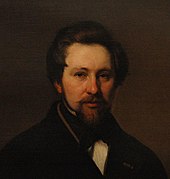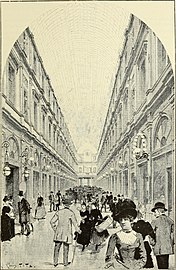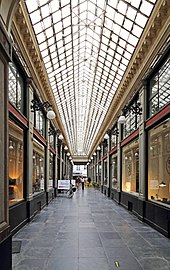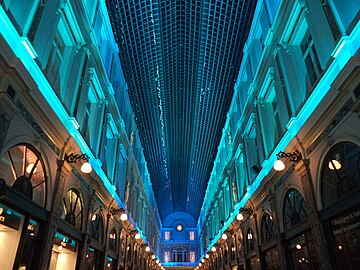
The City of Brussels is the largest municipality and historical centre of the Brussels-Capital Region, as well as the capital of the Flemish Region and Belgium. The City of Brussels is also the administrative centre of the European Union, as it hosts a number of principal EU institutions in its European Quarter.

The Palais-Royal is a former French royal palace located on Rue Saint-Honoré in the 1st arrondissement of Paris. The screened entrance court faces the Place du Palais-Royal, opposite the Louvre. Originally called the Palais-Cardinal, it was built for Cardinal Richelieu from about 1633 to 1639 by architect Jacques Lemercier. Richelieu bequeathed it to Louis XIII, before Louis XIV gave it to his younger brother, the Duke of Orléans. As the succeeding Dukes of Orléans made such extensive alterations over the years, almost nothing remains of Lemercier's original design.

Brussels Park is the largest urban public park in central Brussels, Belgium. Formerly known and still sometimes colloquially referred to as the Royal Park, it was the city's first public park, being originally laid out between 1776 and 1783 in a neoclassical style by the French architect Gilles-Barnabé Guimard and the Austrian landscape architect Joachim Zinner, as part of an urban project including the Place Royale/Koningsplein. The area of the rectangular park is 13.1 ha.
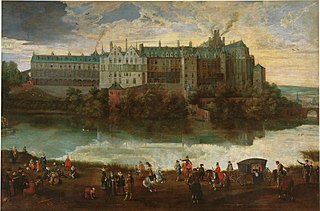
The Palace of Coudenberg was a royal residence situated on the Coudenberg or Koudenberg, a small hill in what is today the Royal Quarter of Brussels, Belgium.

The Centre for Fine Arts is a multi-purpose cultural venue in the Royal Quarter of Brussels, Belgium. It is often referred to as BOZAR in French or by its initials PSK in Dutch. This multidisciplinary space was designed to bring together a wide range of artistic events, whether music, visual arts, theatre, dance, literature, cinema or architecture.

The Congress Column is a monumental column in Brussels, Belgium, commemorating the creation of the Belgian Constitution by the National Congress of 1830–31. Inspired by Trajan's Column in Rome, it was erected between 1850 and 1859, on the initiative of the then-Prime Minister of Belgium, Charles Rogier, according to a design by the architect Joseph Poelaert. At the top of the column is a statue of Belgium's first monarch; King Leopold I, and at its base, the pedestal is surrounded by statues personifying the four freedoms guaranteed under the Constitution. The Belgian Tomb of the Unknown Soldier with an eternal flame lies at its foot.

Jean-Pierre Cluysenaar (1811–1880) was a Belgian architect. He is the father of the Cluysenaar family.

The Bortier Gallery is a glazed shopping arcade in central Brussels, Belgium. It was designed by Jean-Pierre Cluysenaer in 1847, in a neo-Renaissance style, and opened in the following year. As well as being one of the first European shopping arcades, it is a fine example of the joint use of cast iron and glass.

The Marolles or Marollen is a popular historic neighbourhood of downtown Brussels, Belgium. It is situated between the Palace of Justice to its south-east, the Chapel Church to its north and the Halle Gate to its south. Its inhabitants are called Marolliens in French and Marollianen in Dutch.

The Place Royale or Koningsplein is a historic neoclassical square in the Royal Quarter of Brussels, Belgium. Modelled after the so-called French royal square and built between 1775 and 1782, according to a plan of the architects Jean-Benoît-Vincent Barré and Gilles-Barnabé Guimard, to replace the former Palace of Coudenberg, it was part of an urban project including Brussels Park.

The Church of St. James on Coudenberg is a Roman Catholic church located on the historic Place Royale/Koningsplein, in the Royal Quarter of Brussels, Belgium. It is dedicated to Saint James, one of the Twelve Apostles of Jesus.

The Place des Martyrs is a historic square in central Brussels, Belgium. Its current name, meaning "Martyrs' Square", refers to the martyrs of the September Days of the Belgian Revolution of 1830.

The Rue Royale or Koningsstraat is a street in Brussels, Belgium, running through the municipalities of Schaerbeek, Saint-Josse-ten-Noode and the City of Brussels. It is limited to the south by the Place Royale/Koningsplein in the city centre and to the north by the Place de la Reine/Koninginplein in Schaerbeek.
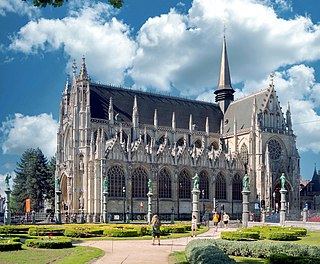
The Sablon or Zavel is a neighbourhood and hill in the historic upper town of Brussels, Belgium. At its heart are twin squares: the larger Grand Sablon or Grote Zavel square in the north-west and the smaller Petit Sablon or Kleine Zavel square and garden in the south-east, divided by the Church of Our Blessed Lady of the Sablon. This area is served by Brussels-Chapel railway station and Brussels-Central railway station, as well as the tram stop Petit Sablon/Kleine Zavel.

The Place de Brouckère or De Brouckèreplein (Dutch) is a major square in central Brussels, Belgium. It was created following the covering of the river Senne (1867–1871), replacing the Temple of the Augustinians, which was demolished in 1893. It is named in honour of Charles de Brouckère, a former mayor of the City of Brussels and professor at the Free University of Brussels, who played a great political role during the Belgian Revolution of 1830. The square measures approximately 50 by 350 metres and is nearly entirely paved.
Events in the year 1847 in Belgium.
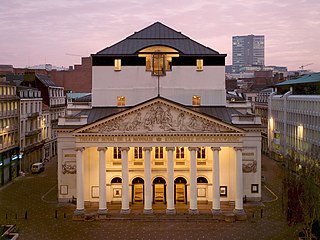
The Place de la Monnaie or Muntplein (Dutch), meaning "Mint Square", is a major square in central Brussels, Belgium. The Royal Theatre of La Monnaie, home to the National Opera of Belgium, is located on this square. It is served by the metro and premetro station De Brouckère on lines 1, 3, 4 and 5.
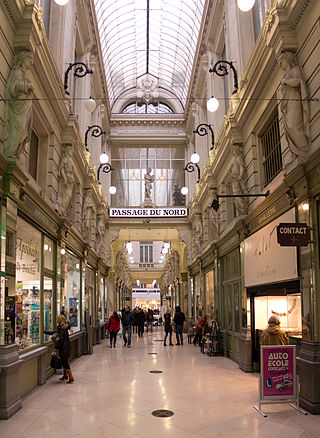
The Passage du Nord (French) or Noorddoorgang (Dutch), meaning "Northern Passage", is a glazed shopping arcade in central Brussels, Belgium. It was built in 1881–82 in an eclectic style by Henri Rieck, following the covering of the Senne and the creation of the Central Boulevards. It is decorated with 32 caryatids in the neoclassical style by Jean-François-Joseph Bertheux and sculptures and putti by Constant Albert Desenfants.
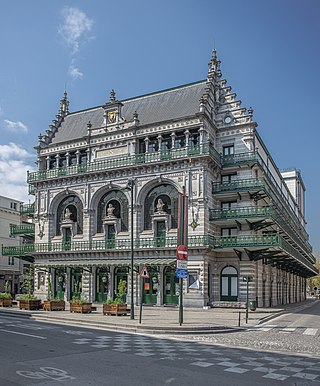
The Royal Flemish Theatre is a theatre in central Brussels, Belgium. It is the anchor of the Flemish theatre company in Brussels, which aims to promote professional theatre in the Dutch language in Belgium and abroad. A place is also made for dance, poetry, music and temporary exhibitions.

The Monument to the Martyrs of the 1830 Revolution, also known as the Pro Patria Monument, is an allegorical monument on the Place des Martyrs/Martelaarsplein in Brussels, Belgium, commemorating the victims of the Belgian Revolution of 1830.


